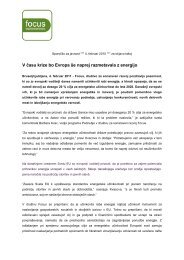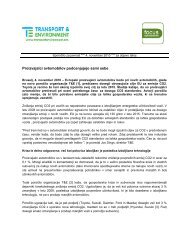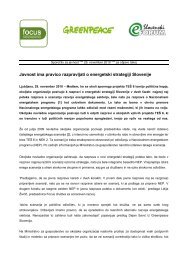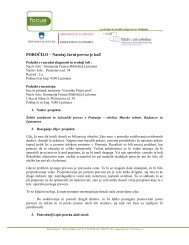E-news update September 5 2006 In this issue: ENERGY ... - Focus
E-news update September 5 2006 In this issue: ENERGY ... - Focus
E-news update September 5 2006 In this issue: ENERGY ... - Focus
Create successful ePaper yourself
Turn your PDF publications into a flip-book with our unique Google optimized e-Paper software.
E-<strong>news</strong> <strong>update</strong> <strong>September</strong> 5 <strong>2006</strong><br />
<strong>In</strong> <strong>this</strong> <strong>issue</strong>:<br />
<strong>ENERGY</strong> AND EMISSIONS<br />
1.1. Romanian NAP published for consultation<br />
1.2. Tests Show Promise for New Environment Friendly Technologies<br />
1.3. Survey predicts private sector to play important role in solving climate change<br />
1.4. US direct action: How American cities have bypassed Bush on Kyoto<br />
1.5. California Strikes Accord on Global Warming Bill<br />
CLIMATE IMPACTS<br />
2.1. Climate change will reach point of no return in 20 years, says expert<br />
CONFERENCES<br />
3.1. The Renewable Resources - Sustainable Future –forum<br />
PUBLICATIONS<br />
4.1. The White House and the Kyoto Protocol: Double Standards on Uncertainties and their<br />
Consequences<br />
4.2. The third report from the Working Group on Climate Change and Development<br />
ANNOUNCEMENTS<br />
5.1. <strong>In</strong>vitation for comments – JI project in Romania<br />
5.2. <strong>In</strong>vitation for comments – JI project in Ukraine<br />
5.3. Climate Deal cyber action<br />
5.4. UK Environment for Europe Fund<br />
<strong>ENERGY</strong> AND EMISSIONS<br />
1.1. Romanian NAP published for consultation<br />
The Romanian Government has published its draft National Allocation Plan (NAP) for the period 2007<br />
and for 2008-2012 for public consultations. Romania has developed the 1st and 2nd NAP as one<br />
integrated document using the same methodology and input data, whenever possible, and aims to<br />
notify the European Commission of both NAPs at the same time.<br />
<strong>In</strong> total 222 installations have been identified. The total amount of allowances are 81.32 Mton in 2007<br />
and 457.39 Mton in 2008-2012. About 47% of national emissions are covered by the EU-ETS.<br />
Romania has applied a two-step approach to allocation with sector caps for the energy sector, metals,<br />
cement, lime, glass, ceramics, and cellulose and paper. The historical reference year emissions have<br />
been taken as the average of the two years with highest emissions in the period 2001-2004. Topdown<br />
macro economic production and emission projections have been leading in the allocation on<br />
sector and installation level. Reductions in carbon intensity have been accounted for on sector level.<br />
Romania intends to allocate a bonus for early action and efficient cogeneration. A new entrants<br />
reserve and a Joint Implementation reserve for current and new JI projects have been set aside.<br />
The NAP has been developed over the last 5 months by MEWM in close cooperation with the Ministry<br />
of Economy and Commerce and the Ministry of Administration and the <strong>In</strong>terior. The Dutch<br />
Government has provided technical assistance through a consortium of Ecofys, CAP SD and local<br />
consultants. The National Environmental Protection Agency has been responsible for the inventory of<br />
installations. The <strong>In</strong>stitute for Studies and Power Engineering (ISPE) has supported the analytical<br />
work.<br />
The draft NAP (main document and annexes) can be found on the website www.eu-ets.ro and on the<br />
website of the Ministry of Environment and Water Management (MEWM) www.mmediu.ro. The<br />
English translation will be available soon. On the website, draft Ministerial Orders on the monitoring<br />
and reporting guidelines and on permitting are also published for public consultations (in Romanian<br />
only). MEWM welcomes comments on the draft NAP until <strong>September</strong> 29th, <strong>2006</strong>.<br />
----------------
1.2. Tests Show Promise for New Environment Friendly Technologies<br />
1 <strong>September</strong> <strong>2006</strong>,<br />
http://yosemite.epa.gov/opa/admpress.nsf/4d84d5d9a719de8c85257018005467c2/b57e194f75be69a<br />
b852571dc004ecd66!OpenDocument<br />
Emissions of the most potent greenhouse gas, sulfur hexafluoride (SF6), could be history in less than<br />
four years, according to results of pilot tests conducted by the Environmental Protection Agency and<br />
the magnesium industry. Preliminary results show that alternative technologies have the potential to<br />
replace SF6, which is used to prevent oxidation and burning of molten metal.<br />
"By investing in innovative technologies, our country's environmental well being will improve," said Bill<br />
Wehrum, EPA acting assistant administrator for Air and Radiation. "The Bush Administration<br />
understands that international collaboration will lead the way in identifying technologies that protect<br />
our global environment."<br />
Led by EPA's SF6 Emission Reduction Partnership for the Magnesium <strong>In</strong>dustry, a group of companies<br />
and researchers from Australia, Canada, Japan, and the U.S. conducted the tests and emission<br />
measurements for cutting-edge, climate friendly melt protection technologies that promise significant<br />
environmental benefits.<br />
EPA's Magnesium Partnership is a cooperative effort between EPA and industry to reduce and<br />
eliminate emissions of sulfur hexafluoride from magnesium production and casting processes through<br />
cost-effective technologies and practices. Eliminating emissions from SF6 about three million metric<br />
tons of carbon dioxide equivalent annually is roughly equal to emissions from 500,000 vehicles per<br />
year.<br />
The Bush Administration has committed financial, international and domestic resources to reducing<br />
greenhouse gas emissions. The president’s policy achieves near-term reductions, while investing in<br />
long-term solutions. <strong>In</strong> 2004, EPA’s voluntary partnerships prevented over 60 million metric tons of<br />
greenhouse gas emissions, equivalent to the annual emissions from over 40 million vehicles. EPA's<br />
climate programs continue to exceed the agency’s greenhouse gas emissions goals and are on target<br />
to meet the president's goal to reduce greenhouse gas intensity 18 percent by 2012.<br />
More information about EPA’s SF6 Emission Reduction Partnership for the Magnesium <strong>In</strong>dustry:<br />
http://www.epa.gov/highgwp/magnesium-sf6/<br />
--------------<br />
1.3. Survey predicts private sector to play important role in solving climate change<br />
31 August <strong>2006</strong><br />
Companies and business associations will be the most effective organizations in developing and<br />
implementing solutions to climate change, according to a recent survey.<br />
And such solutions are urgently needed: Experts doubt that the current progress on climate change<br />
will be fast enough to avert major, irreversible damage, and one third believe it is already too late.<br />
The survey, conducted by GlobeScan with the support of the COM+ Alliance, explored sustainability<br />
experts' views on approaches to climate change for the post-2012 period after the expiration of the<br />
Kyoto Protocol.<br />
Almost half of the experts (46%) believe that the World Business Council for Sustainable Development<br />
(WBCSD) will play a major role in defining or implementing climate change solutions over the next five<br />
years - second only to the European Union (79%). The Council is also named as one of 13<br />
organizations/entities currently most influential in defining or implementing climate change solutions,<br />
and - alongside the <strong>In</strong>tergovernmental Panel on Climate Change (IPCC) – the preferred source of<br />
information on <strong>this</strong> topic.<br />
What will climate change solutions look like? Experts predict that economic instruments, new science<br />
and technology, and regulatory approaches will be the most effective approaches in the post-Kyoto<br />
world. More see the development of renewable energy sources as an effective solution to climate<br />
change than those who think that bio-fuels, clean coal combustion or carbon capture and<br />
sequestration are the best solutions. Among financial mechanisms explored, carbon taxes and<br />
emission trading are seen as potentially the most effective instruments.<br />
Sixty-five percent of the respondents expect that private sector companies and business associations<br />
will be leading the implementation of appropriate solutions in the coming years, though currently<br />
governments are seen to be influencing society's reaction to climate change the most.<br />
"Experts clearly expect the private sector to play an increasingly important role in addressing climate<br />
change. Other findings, however, suggest that companies require a clear policy context from<br />
governments before investing heavily in developing solutions to climate changes", says the survey.
The Formative Research for the Climate Forum: A Survey of Sustainability Experts and in-depth<br />
<strong>In</strong>terviews with Climate Change Solution Providers, conducted by the international opinion research<br />
firm GlobeScan <strong>In</strong>corporated with the support of COM+ Alliance, explored sustainability experts' views<br />
on approaches to climate change for the post-2012 period to understand the network of influence<br />
within the climate change community that will determine what types of solutions are developed and<br />
implemented in the coming years.<br />
GlobeScan and its partners will use the research to help design and build a global panel of 5,000<br />
influential climate change “solution providers” who will be surveyed regularly and the results broadly<br />
publicized. These proposed “Climate Forum” surveys will successively build on each previous one to<br />
quantify and analyze areas of agreement and contention within the climate change debate.<br />
More: http://www.wbcsd.org/plugins/DocSearch/details.asp?type=DocDet&ObjectId=MjAyMjU;<br />
Download the survey: http://www.wbcsd.org/includes/getTarget.asp?type=d&id=MjAyMjY.<br />
--------------------<br />
1.4. US direct action: How American cities have bypassed Bush on Kyoto<br />
1 <strong>September</strong> <strong>2006</strong>, The <strong>In</strong>dependent<br />
It is not just the state of California that is bypassing the authority of the US government to take action<br />
on global warming.<br />
The mayors of more than 300 cities across the country have signed a Climate Protection Agreement in<br />
which they have pledged to meet the emissions-cutting timetable laid down by the Kyoto Protocol -<br />
regardless of what the Bush administration decides.<br />
Some of those cities, such as Seattle, which took the lead on drafting and lobbying for the agreement,<br />
are bastions of liberal politics and environmentalism, acting out their ideological convictions. Others,<br />
though, such as the exclusive Colorado ski resorts Vail and Aspen, are also motivated by a powerful<br />
self-interest. If global warming continues unabated, the Rocky Mountain snowpack will melt and there<br />
will be no skiing in Vail, Aspen or anywhere else by the end of <strong>this</strong> century.<br />
Seattle's Mayor, Greg Nickels, proposed the mayors' agreement whenKyoto came into effect at the<br />
start of last year. By June 2005, he had 140 signatories, and the number has more than doubled<br />
since.<br />
The goal is to "meet or exceed" the Kyoto target of cutting global warming pollution to 7 per cent<br />
below 1990 levels by 2012.<br />
The agreement also contains a 12-point action plan, urging signatory cities to discourage sprawl,<br />
promote public transport, car-pooling and bicycle lanes, turn to alternative energy sources including<br />
alternative fuels for the municipal vehicle and bus fleet, plant lots of trees and introduce<br />
environmental education programmes in schools and community colleges.<br />
Seattle, in the Pacific Northwest, is the perfect poster-child for many of these initiatives, since it sits<br />
between two heavily forested mountain ranges and is surrounded by water. Despite a long history of<br />
environmentalism and commitment to public transport, it has been struggling with smog problems in<br />
recent years because of heavy car commuter traffic from the ever-expanding suburbs.<br />
The Colorado ski resorts, meanwhile, have taken robust action to convert to renewable energy to<br />
power their ski lifts, shops, hotels and administrative buildings.<br />
Vail just signed a deal to buy more than 150,000 megawatt-hours of wind power per year - the<br />
greenhouse gas-saving equivalent of taking 18,000 cars off the roads. Aspen, meanwhile,<br />
commissioned a study in April that revealed the severe damage done to the environment by private<br />
jets landing at its airport. It is now working to curtail air traffic.<br />
Aspen's top city lawyer, John Worcester, described the city earlier <strong>this</strong> year as the global-warming<br />
equivalent of "the canary in the miner's cage". "It is incumbent on all of us," he said, "to face the<br />
potential threat upon our economy and way of life as we would any other potential threat".<br />
---------------<br />
1.5. California Strikes Accord on Global Warming Bill<br />
31 August <strong>2006</strong>, Planet Ark Reuters<br />
California catapulted to the forefront of US efforts to fight global warming on Wednesday with an<br />
accord that will give the state the toughest laws in the nation on cutting greenhouse gas emissions.<br />
Gov. Arnold Schwarzenegger, who has accused fellow Republican President George W. Bush of lacking<br />
leadership on climate change, said he reached a "historic agreement" with Democrats to make<br />
California a world leader in reducing carbon emissions.
"The success of our system will be an example for other states and nations to follow as the fight<br />
against climate change continues," Schwarzenegger said in a statement.<br />
The bill now seems certain to win approval <strong>this</strong> week in a vote in the Senate and the Assembly, where<br />
Democrats hold majorities. Thursday is the last day of the legislative session ahead of November<br />
elections.<br />
Despite opposition from within his own party, Schwarzenegger was expected to support the bill since<br />
he has made much of his environmental record in his reelection bid.<br />
Green policies are popular among voters in environment-savvy California, the world's eighth-biggest<br />
economy and the 12th largest producer of greenhouse gas emissions.<br />
California's Global Warming Solutions Act aims to cut emissions to 1990 levels by 2020 with an<br />
enforceable cap and mandatory reporting for top polluters like energy companies.<br />
The United States is the world's largest producer of the heat-trapping gases that many scientists link<br />
to extreme weather like violent hurricanes and rising sea levels.<br />
But Bush pulled the United States out of the 160-nation Kyoto Protocol to cut greenhouse gas<br />
emissions in 2001, arguing that it would hurt the economy and unfairly excluded developing nations<br />
like China.<br />
-------------<br />
CLIMATE IMPACTS<br />
2.1. Climate change will reach point of no return in 20 years, says expert<br />
5 <strong>September</strong> <strong>2006</strong>, The Guardian<br />
The world only has 10 years to develop and implement new technologies to generate clean electricity<br />
before climate change reaches the point of no return - something the UK government failed to<br />
appreciate in its recent energy review, according to an expert.<br />
Speaking at the British Association festival of science in Norwich yesterday, Peter Smith, a professor of<br />
sustainable energy at the University of Nottingham, said the UK had to embark on a strategy to<br />
reduce energy use by insulating homes better and encouraging more micro-generation schemes such<br />
as solar panels.<br />
"The scientific opinion is that we have a ceiling of 440 parts per million [ppm] of atmospheric carbon<br />
before there is a tipping point, a step change in the rate of global warming," said Professor Smith.<br />
"The rate at which we are emitting now, around 2ppm a year and rising, we could expect that that<br />
tipping point will reach us in 20 years time. That gives us 10 years to develop technologies that could<br />
start to bite into the problem."<br />
The current level of carbon dioxide in the atmosphere is 380ppm.<br />
He said the government's recent energy review had failed to address the problem and had simply<br />
reiterated two long-held assumptions: that wind power should provide 15% of electricity by 2020 and<br />
that renewable energy alone could not fill the energy gap left by the decommissioning of nuclear and<br />
the demise of fossil-fuel power stations. The solution presented was to build a new generation of<br />
nuclear power stations.<br />
"Astonishingly, the review pays hardly any regard to the principle energy asset which <strong>this</strong> country<br />
enjoys, namely its rivers, estuaries, coastal currents and waves," said Prof Smith. "Huge amounts of<br />
energy could be harvested using existing technologies, which could meet the nuclear shortfall several<br />
times over." A tidal energy barrage across the Severn river, for example, could have a peak output of<br />
around six gigawatts, more than 10% of the country's peak demand.<br />
"The technology is robust, simple, it's basically a water-wheel," said Prof Smith. "To say it is too<br />
innovatory, which the government has done, is rubbish."<br />
There are several sites around Britain with similar energy potential, including the Channel Islands, he<br />
said.<br />
According to the Energy Savings Trust, homes in the UK have the potential to provide 40% of their<br />
own electricity using micro-generation."The ultimate goal for our homes is to make them near carbonneutral<br />
and, at best, make them net contributors of clean energy," said Prof Smith. "<strong>In</strong> the long term,<br />
a combination of demand reduction and the full complement of renewables could make the UK<br />
virtually carbon free."<br />
But he was not optimistic that the government would make these changes voluntarily. "What will<br />
overcome [government apathy] is when there's a two-metre rise in the Thames so that the House of<br />
Commons is under water," he said. "The tragedy is that there needs to be a fairly catastrophic event
to motivate politicians to take action, [so] they feel confident that the public will vote for them next<br />
time."<br />
The Met Office believes the Thames estuary is the most vulnerable place in northern Europe to major<br />
storm surges. The existing barrage could be overwhelmed at almost any time, and estimates suggest<br />
<strong>this</strong> could cause £30bn of damage to London and the surrounding areas.<br />
--------------<br />
CONFERENCES<br />
3.1. The Renewable Resources - Sustainable Future –forum<br />
During Finnish EU presidency, the Finnish forest sector wishes to contribute to competitiveness,<br />
sustainability and well-being in Europe, by pointing out the multiple potentials related to renewable<br />
natural resources, e.g. forests and wood.<br />
The Finnish Forest Association invites European deciders and opinion leaders from the fields of<br />
forestry, environment, rural development, energy, and industrial ecology to participate to <strong>this</strong> crosssectoral,<br />
future-looking forum and output oriented forum. The working methods include interactive<br />
approaches and modern group work methods to highlight the role of renewables, and to compile<br />
messages to ongoing policy and strategy processes. For further information on the event, please visit<br />
the website http://www.smy.fi/renewableresources/index.html.<br />
The Renewable Resources - Sustainable Future -forum will take place in Helsinki on 2nd November<br />
<strong>2006</strong>. An evening reception will be organisaed the previous night and a half-day excursion for the<br />
interested will be organised on November 3rd. The registration is free of charge, but the participants<br />
are expected to pay their transport to Helsinki and their accomodation at the Congress site.<br />
They have 5 open places for registration to the forum to the persons who find interest in the use of<br />
renewables and it's relation to competitiveness and European well-being. If you are interested, please<br />
send a message to renewableresources@smy.fi or to the project manager tina.byring@smy.fi.<br />
----------------<br />
PUBLICATIONS<br />
4.1. The White House and the Kyoto Protocol: Double Standards on Uncertainties and their<br />
Consequences<br />
Tulkens, Philippe and Tulkens, Henry, (June <strong>2006</strong>). FEEM Working Paper No. 89.06 Available at SSRN:<br />
http://ssrn.com/abstract=910811.<br />
Abstract: This paper compares the level of uncertainty widely reported in climate change scientific<br />
publications with the level of uncertainty of the costs estimates of implementing the Kyoto Protocol in<br />
the United States. It argues that these two categories of uncertainties were used and ignored,<br />
respectively, in the policy making process in the US so as to challenge the scientific basis on the one<br />
hand and on the other hand to assert that reducing emissions would hurt the economy by an amount<br />
stated without any qualification. The paper reviews the range of costs estimates published since 1998<br />
on implementing the Kyoto Protocol in the US. It comments on the significance of these cost<br />
estimates and identifies a decreasing trend in the successive estimates. This implies that initially some<br />
of the most influential economic model-based assessments seem to have overestimated the costs, an<br />
overestimation that may have played a significant role in the US decision to withdraw from the<br />
Protocol. The paper concludes with advocating that future economic estimates always include<br />
uncertainty ranges, so as to be in line with a basic transparency practice prevailing in climate science.<br />
-------------<br />
4.2. The third report from the Working Group on Climate Change and Development<br />
The report catalogues the impact of climate change and environmental degradation ranging from<br />
drought in the Amazon to floods in Haiti and elsewhere; vanishing glaciers in Colombia to extreme<br />
cold in the Andes; and hurricanes, not only in Central America and the Caribbean, but also in southern<br />
Brazil.<br />
Up in smoke? Latin America and the Caribbean: The threat from climate change to the environment<br />
and human development can be downloaded in English:<br />
http://www.neweconomics.org/gen/uploads/15erpvfzxbbipu552pnoo1f12808<strong>2006</strong>213002.pdf.<br />
And Spanish:<br />
http://www.neweconomics.org/gen/uploads/15erpvfzxbbipu552pnoo1f12808<strong>2006</strong>213236.pdf.
------------------<br />
ANNOUNCEMENTS<br />
5.1. <strong>In</strong>vitation for comments – JI project in Romania<br />
DNV Certification is currently making a determination of the New 20MW cogeneration equipment in<br />
CET Timisoara Centru project in Romania. The project, proposed as Joint Implementation (JI) project<br />
between Romania and The Netherlands, is an energy sector project, which consists of installing a new<br />
cogeneration combined cycle of about 20 MWe (gas turbine + heat recovery steam generator + steam<br />
turbine) in the existing cogeneration plant.The goal of the project is to upgrade the existing heat<br />
production plant CET Timisoara Centru with new cogeneration capabilities.<br />
We herewith invite comments from Parties, stakeholders and observers in accordance with the JI rules<br />
and modalities. Comments may be provided during a period of 30 days until 1st October <strong>2006</strong> on the<br />
DNV Climate Change webpage http://www.dnv.com/certification/ClimateChange/. After that the<br />
project is closed for comments, but the project documentation is still available for review.<br />
--------------<br />
5.2. <strong>In</strong>vitation for comments – JI project in Ukraine<br />
The TÜV NORD JI/CDM Certification Program has been commissioned to carry out the validation of<br />
the project "Donbasskaya 3 - Utilisation of Coal Mine Methane (CMM) for heat generation and flaring".<br />
Project description: <strong>In</strong> the Donbass area very large amounts of CMM occur. At the time most of the<br />
CMM is released to the atmosphere using degassing wells, which are often placed in the steppe far<br />
away form residential and industrial areas, so that is often impossible to use the CMM for heat<br />
generation economically. Because the electricity price is very low in Ukraine and there are no existing<br />
laws for supporting environmentally friendly energies like CMM, CMM can not be used in cogeneration<br />
units for power generation at economical conditions. Consequently most of the CMM in the Donbass<br />
area is released unused into the atmosphere.<br />
<strong>In</strong> <strong>this</strong> project CMM from the suction system of the coal mine Donbasskaya 3, which is concurrently in<br />
construction, should be used in a boiler for heat generation. Additionally a flare for further methane<br />
destruction should be installed.<br />
Actually there are three existing redundant steam boilers in operation with an output of 25 t/h steam<br />
each. The boilers are fired with coal and supply the coal mine facilities with heat (steam).<br />
<strong>In</strong> <strong>this</strong> project one of the existing boilers should be fuel-switched. The boiler should be upgraded with<br />
a CMM burner system and henceforth be fired with CMM instead of coal.<br />
Due to the large amount of CMM occurring on the coal mine, additionally a flare with a firing capacity<br />
of 5.0 MW should be installed. If the experience with the flare will be good and the amount of CMM<br />
remains high, further flares may follow.<br />
According to the modalities for the validation of JI-projects, we invite all interested parties,<br />
stakeholders and observers to comment on the project. The PDD can be downloaded from our<br />
website: http://www.global-warming.de/e/1512/.<br />
The project is open for comments from <strong>2006</strong>-08-30 on for 30 days.<br />
-------------------<br />
5.3. Climate Deal cyber action<br />
The global climate is in high danger of catastrophic change. Because we consume too much energy<br />
too inefficiently, we release large amounts of greenhouse gases into the atmosphere that heat up the<br />
planet.<br />
Everyone needs to help fight the crisis. You can make small changes to your own lifestyle, but even<br />
your best efforts will not save the climate unless governments pull their weight, too, and get tough on<br />
greenhouse gas emissions. Currently, governments are not doing enough!<br />
If thousands of people show their government that they are ready to act, governments will not be<br />
able to shy away from doing their bit, too! So we invite people to challenge their governments with a<br />
personal "Climate Deal", showing that you are ready to fight climate change, and that you demand<br />
real government action in return!<br />
A typical "Climate Deal" could be: "I will use my bike more often. <strong>In</strong> return the government should<br />
give more support to renewable energy!" -- but there are plenty of other ideas.<br />
Join the action: Upload your photo and leave your personal "Climate Deal" at<br />
http://www.foeeurope.org/climatedeal.
-----------------<br />
5.4. UK Environment for Europe Fund<br />
The UK Environment for Europe Fund was launched by the Secretary of State for Environment Food<br />
and Rural Affairs, Margaret Beckett at the 5th Ministerial Environment for Europe Conference which<br />
took place in Kiev on 21-23 May 2003.<br />
The broad aims of the Fund are to promote environmental protection and sustainable development in<br />
Central and Eastern Europe, Caucasus and Central Asia and to support activities of environmental<br />
organisations in these countries.<br />
The Fund is a successor to the former Environmental Know How Fund which was created in the early<br />
1990s by the then Department for the Environment and merged with the assistance programmes of<br />
the Department for <strong>In</strong>ternational Development in 1999.<br />
The UK Environment for Europe Fund is managed by the Department for Environment, Food and Rural<br />
Affairs (Defra). <strong>In</strong> many cases Defra works in partnership with other agents, including the Department<br />
for <strong>In</strong>ternational Development (DFID); British Council; United Nations Economic Commission for<br />
Europe; the Environmental Action Programme Task Force; the Regional Environment Centres and<br />
other non-governmental organisations working in the region.<br />
Priorities for <strong>2006</strong>/2007<br />
Fifth round of applications in <strong>2006</strong> : Call for Proposals for the PECE <strong>In</strong>itiative<br />
Defra has announced the start of the fifth round of applications for the Partners for Environmental<br />
Cooperation in Europe (PECE) initiative to promote sustainable development in Eastern Europe,<br />
Caucasus and Central Asia (EECCA) region from the Environment for Europe fund. The fund will only<br />
cover up to half of the cost of each project and the rest of the funding should be secured in advance<br />
of any application by the partner organisations from other sources.<br />
The projects must have PECE branding and only PECE branded projects will be considered for funding.<br />
The deadline for submitting applications is 16 October <strong>2006</strong>. Completed application forms should be<br />
sent to Iuliiana.best@defra.gsi.gov.uk and Lydia.breslin@defra.gsi.gov.uk.<br />
Please, see more http://www.defra.gov.uk/environment/internat/enveurofund/index.htm<br />
-------------<br />
>>>>>>>>>>>>>>>>>>>>>>>>>>>>>>>>













